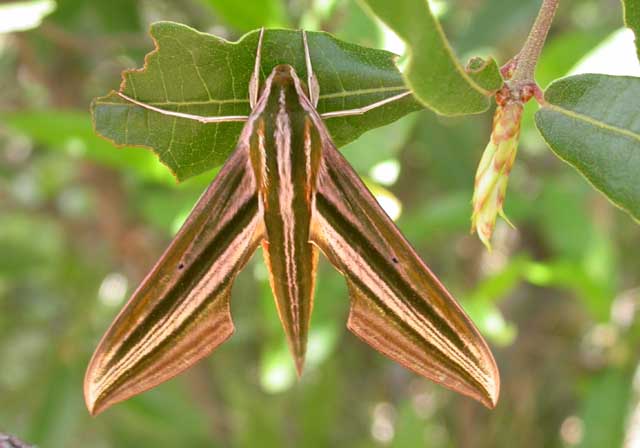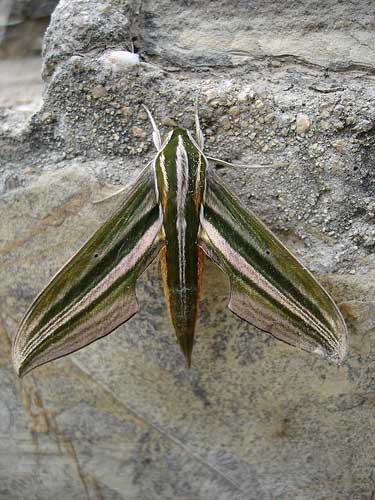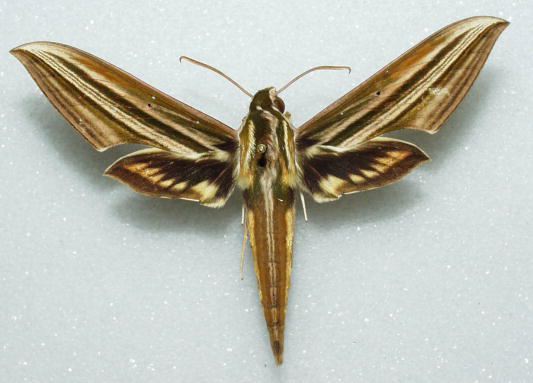Xylophanes eumedon
Xylophanes eumedon
(Boisduval, [1875]), Choerocampa

Xylophanes eumedon, Zacatecas, Mexico, courtesy of
Jean Haxaire.
This site has been created by
Bill Oehlke at oehlkew@islandtelecom.com
Comments, suggestions and/or additional information are welcomed by Bill.
TAXONOMY:
Family: Sphingidae, Latreille, 1802
Subfamily: Macroglossinae, Harris, 1839
Tribe: Macroglossini, Harris, 1839
Genus: Xylophanes Hubner [1819] ...........
Species: eumedon Boisduval, [1875]
|
MIDI MUSIC
.....It's a Wonderful World.....
copyright C. Odenkirk
ON.OFF
<bgsound src="world.mid" LOOP=FOREVER>
|
DISTRIBUTION:
Xylophanes eumedon moths fly in
Mexico (specimen type locality) southwards possibly into
?? Guatemala.

Xylophanes eumedon male, Monte Alban, Mexico,
October 3, 2008, courtesy of Frederic Pan.
"Similar to Xylophanes aristor but smaller and forewing pattern much more contrasted. Immediately distinguishable from related species
(except Xylophanes mulleri) by the partial fusion and apical pinkish flush of the pale yellow spots of the median band of the hindwing upperside.
"Tegula with a pale medial line. Upperside of abdomen with two narrow, pale lines, divided medially by a sharp, thin brown line of the same width; a black basal patch and a
conspicuous longitudinal golden-yellow bands on either side of the anterior part of the abdomen.
"Outer spur of midtibia longer than inner.
Forewing upperside with first postmedian line broad and very well-marked; second postmedian line fused to first below M3; interspaces between first and third
postmedian lines very pale.
"Forewing underside with apical area on costa pale buff, contrasting strongly with the orange-yellow ground colour.
"Median band of the hindwing upperside with pale yellow spots less distinct, edges suffused with orange-brown, most apical three spots more or less fused." CATE

Xylophanes eumedon, Mexico, courtesy of Manuel Balcazar-Lara.
FLIGHT TIMES:
Xylophanes eumedon adults probably
brood continuously.
ECLOSION:
Pupae probably wiggle to surface from
subterranean chambers just prior to eclosion.
SCENTING AND MATING:Females call in the males with a
pheromone released from a gland at the tip of the
abdomen.
Males come in to lights very readily, but females are seldom taken in
that way.
EGGS, LARVAE, PUPAE:
Larvae probably feed on
Psychotria panamensis and Psychotria nervosa
of the Rubiaceae family and on
Pavonia guanacastensis of the Malvaceae family.
Moths emerge approximately one-two months after larvae pupate.
Use your browser "Back" button to return to the previous page.
Goto Main Sphingidae Index
Goto Macroglossini Tribe
Goto Central American Indices
Goto Carribean Islands
Goto South American Indices
Goto U.S.A. tables


